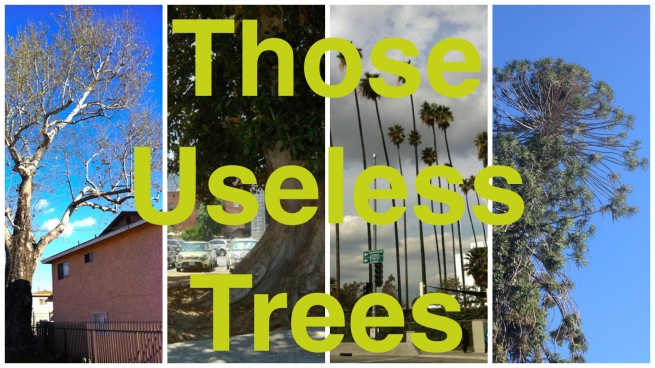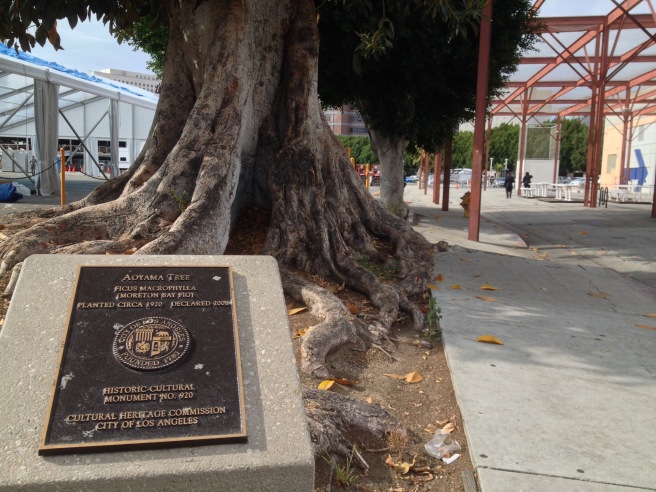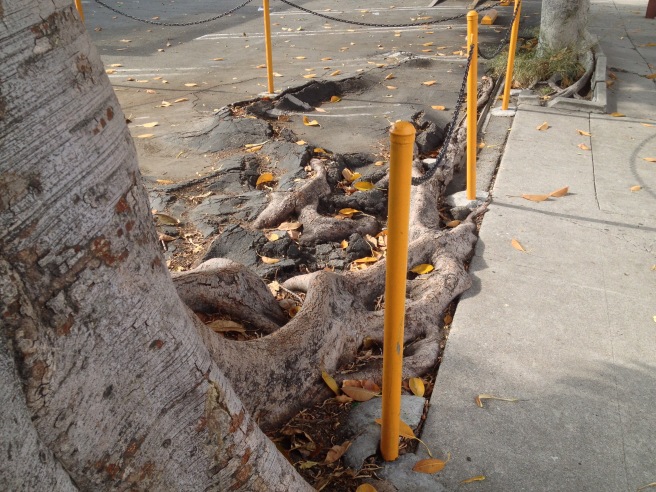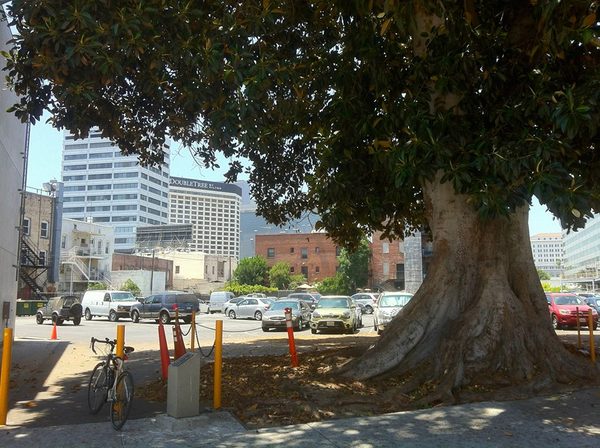
Although not native, many Moreton Bay Figs (Ficus macrophylla) dot the Southern California landscape. The oldest of these Australian immigrants might be those planted by agriculturalist Elijah Hook Workman on the Los Angeles Plaza in 1875. Around that same time, one was planted in Anaheim which later served as the model for the Disneyland‘s Swiss Family Robinson Treehouse. One planted in Santa Barbara in 1876 is the largest specimen in the US. The tallest local Moreton Bay fig is located next to to San Diego‘s Natural History Museum. Because it’s Asian Pacific American Heritage Month, I decided to look at one with significance to Los Angeles’s Japanese community, the so-called Aoyama Tree.

Moreton Bay Fig trees are large, evergreen, banyan trees native to most of the eastern coast of Australia, from the Atherton Tableland in the north to the Shoalhaven River in the south. Its common name is derived from Moreton Bay in Queensland. A specimen grown in Europe was first scientifically described by French botanist René Louiche Desfontaines in the early 1800s. The trees are now common not in many parts of the world, especially California, Hawaii, Portugal, Italy, New Zealand, and South Africa. The trees are especially popular in parks, where they provide ample shade and can find sufficient space for their distinctive network of buttress roots, which require more space than most urban yards provide — although there are exceptions such as Rancho Los Alamitos in Long Beach.
The approximately twenty meter tall Aoyama Tree was planted in 1920. It’s located in a parking lot next to the National Center for the Preservation of Democracy and Geffen Contemporary MOCA. It was formerly the location of the Koyasan Daishi Mission, founded by Reverend Shutai Aoyama in 1912.

Reverend Aoyama moved to the US in 1909 and originally his mission met in a storefront on Commercial Street. In 1920 he moved his temple to the location of a former restaurant at 133 North Central Avenue. There he planted his tree.

Boy Scout Troop 379, still associated with the temple, were named an outstanding troop by Franklin D. Roosevelt in 1935. In 1937, Koyasan Temple bought a new plot of land and began building a new temple, completed in 1940. In 1942, the same President Roosevelt signed and issued Executive Order 9066, which led to the forced internment of Japanese-Americans in concentration camps, based upon their ethnic origins in a country with which the US was at war. The camps were closed in 1946 and the Koyasan congregation reconvened in 1950.

The former site of the temple was razed along with an entire block of residential and commercial buildings to clear the way for the construction of Parker Center in 1952. Of course every development in the 20th century required an attendant parking lot and the Parker Center was no exception. Although much of its network of roots was paved over, the tree was allowed to remain.
In 1970, the Community Redevelopment Agency (CRA) launched the Little Tokyo Project, targeting most of Little Tokyo’s older structures with demolition and residents with eviction so that Japanese firms could build commercial highrises in their place. Residents formed The Little Tokyo People’s Rights in 1973 to represent a community faced with a second round of relocation. The residential Alan, Masago, and Sun hotels were demolished but the Aoyoma tree remained, as did the stretch of buildings along 1st Street, which were designated The Little Tokyo Historic District and declared a National Historic Landmark in 1995.

In 2007, Deanna Matsumoto of the Little Tokyo Historical Society filed an application to designate the tree as a Los Angeles Historic-Cultural Monument and in 2008, the tree was added to that list, making it Los Angeles Historic-Cultural Monument #920, where it joins Westside Village‘s Moreton Bay Fig Tree (Los Angeles Historic-Cultural Monument #19), University Park‘s Ecung-Ibbetson House and Moreton Bay Fig Tree (Los Angeles Historic-Cultural Monument #350), and Los Feliz’s North Vermont Avenue Moreton Bay Fig Trees (Los Angeles Historic-Cultural Monument #940).
FURTHER READING
Joanna Lin‘s Fig tree is center of attention in Little Tokyo
The Cultural Landscape Foundation‘s Aoyama Tree
Nathan Masters‘s Majestic Mammoths: A Brief History of L.A.’s Moreton Bay Fig Trees
Eric Brightwell is an adventurer, essayist, rambler, explorer, cartographer, and guerrilla gardener who is always seeking paid writing, speaking, traveling, and art opportunities. He is not interested in generating advertorials, cranking out clickbait, or laboring away in a listicle mill “for exposure.”
Brightwell has written for Angels Walk LA, Amoeblog, Boom: A Journal of California, diaCRITICS, Hidden Los Angeles, and KCET Departures. His art has been featured by the American Institute of Architects, the Architecture & Design Museum, the Craft Contemporary, Form Follows Function, Los Angeles County Store, the book Sidewalking, Skid Row Housing Trust, and 1650 Gallery. Brightwell has been featured as subject in The Los Angeles Times, Huffington Post, Los Angeles Magazine, LAist, CurbedLA, Eastsider LA, Boing Boing, Los Angeles, I’m Yours, and on Notebook on Cities and Culture. He has been a guest speaker on KCRW‘s Which Way, LA?, at Emerson College, and the University of Southern California.
Brightwell is currently writing a book about Los Angeles and you can follow him on Ameba, Duolingo, Facebook, Goodreads, Instagram, Mubi, and Twitter.




Are “those useless trees” a reference to the Pulp song? If so, 💓!
LikeLike
yes indeed — my favorite band most days!
LikeLike
Awesome!! Mine too, for sure! I realized later I meant Jarvis Cocker, it was his voice I heard singing the title. 🙂 I’m so happy I’ve found your blog as a new Los Angelino – it is so fascinating and well researched – I’ll have many inspired explorations ahead -thank you!!!
LikeLike
You’re very welcome. I hope that you enjoy living in Los Angeles. It’s not the easiest city to wrap your head around so my advice is try different approaches and I hope that you love it.
LikeLike